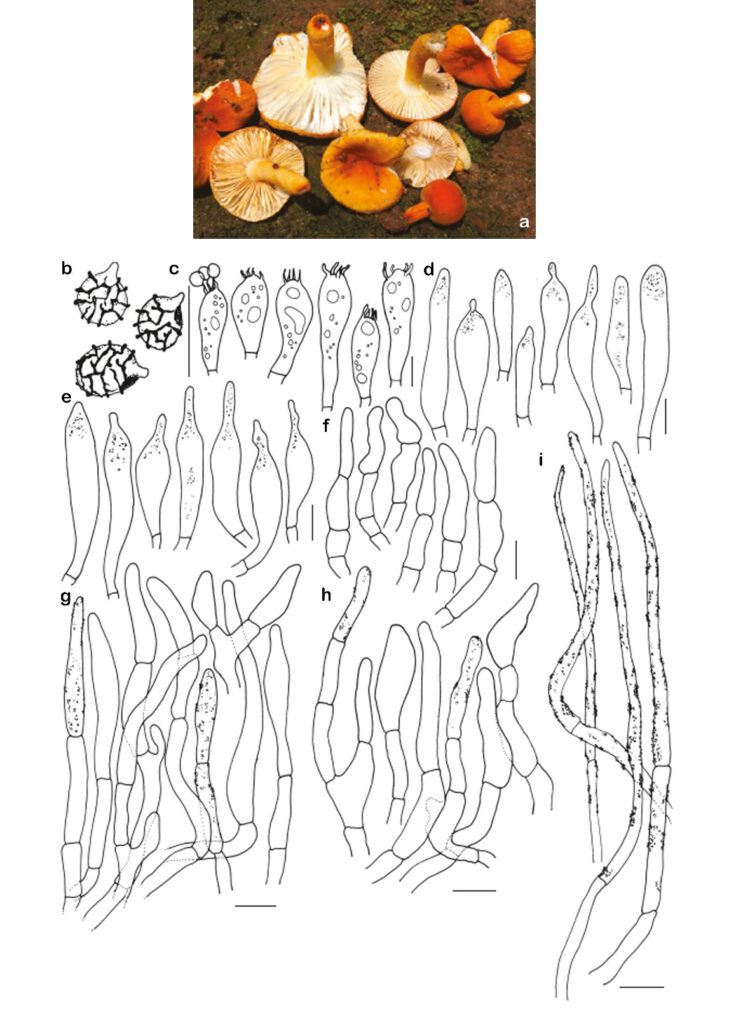Fungalpedia – Note 136 Russula
Russula Pers.
Citation if using this entry: Bera et al. (in prep) Basidiomycota. Mycosphere
Index Fungorum, Facesoffungi, MycoBank, GenBank, Fig. 1
Basidiomycota, Agaricomycetes, Russulales, Russulaceae
The family Russulaceae is a diverse group of agaricoid mushrooms, and the genus Russula is one of the most prominent members of this family. In “Observationes Mycologicae,” C.H. Persoon first circumscribed the genus and identified key traits such as the fleshy nature of the basidiomata, the sunken pileus, and the uniform lamellae arrangement as defining characteristics (Persoon 1796). Russula is one of the most taxonomically diverse and commonly encountered ectomycorrhizal mushrooms (Kalichman et al. 2020) thriving across diverse environments from arctic tundra to tropical rainforests (Looney et al. 2018). Commonly known as “brittle gills” (Marley 2010), this genus has been extensively studied across the globe accounting for approximately 2000 species (Adamčík et al. 2019).
The Latin origin of the name “Russula” directly reflects its vibrant nature, as it translates to “red,” alluding to the colorful appearance of these mushrooms (Schalkwijk-Barendsen 1991). Apart from this, the amyloid basidiospore ornamentation, the brittleness of the basidiomata due to abundant sphaerocytes, and the presence of gloeoplerous elements are its characteristic features (Ghosh et al. 2023). The complete absence of the lactiferous hyphae is the basis of its differentiation from the similar-looking sister genera Lactarius Pers. and Lactifluus (Pers.) Roussel (Buyck et al. 2018). A comprehensive investigation of the North American Russula by Buyck (2007) revealed 419 different species. However, he speculated that the actual count for the subcontinent could potentially be three to four times greater than this (Adamčík et al. 2019). This hypothesis was later backed up by Looney et al. (2016). Since then, the identification of various species of the genus has been attributed to the growing utilization of molecular evidence to define species boundaries, leading to a notable increase in the number of newly published species within the genus (Adamčík et al. 2019). The current infrageneric classification of Russula is based on the combination of ectomycorrhizal anatomy with multi-locus (nrLSU, mtSSU, rpb2, rpb1 and tef-1) phylogenetic analysis by Buyck et al. (2018, 2020) (Ghosh et al. 2023).
Some Russula species like R. vesca Fr., R. brevipes Peck, and R. virescens (Schaeff.) Fr. are preferred for their culinary uses, but it is quite challenging to discriminate edible species from the toxic ones.
Type species: Russula emetica (Schaeff.) Pers.
Figure 1. Russula pseudoflavida A. Ghosh, Hembrom, I. Bera & Buyck (holotype): a. Basidiomata. b. Basidiospore. c. Basidia. d. Hymenial gloeocystidia near the lamellae edges. e. Hymenial gloeocystidia near the lamellae sides. f. Marginal cells. g. Elements of the pileipellis near the pileus margin: hyphal terminations. h. Elements of the pileipellis near the pileus centre: hyphal terminations. i. Doubtful primordial hyphae. Scale bars: b-i = 10 μm. Drawing and picture from Ghosh et al. 2023.
References
Adamčík S, Looney B, Caboň M, Jančovičová S, Adamčíková K, Avis PG, … Buyck B 2019 – The quest for a globally comprehensible Russula language. Fungal Diversity, 99, 369–449. https://link.springer.com/article/10.1007/s13225-019-00437-2
Buyck B 2007 – An introduction to the study of Russula in the eastern United States. Pagine di Micologia, 27, 81–86.
Buyck B, Wang XH, Adamcikova K, Cabon M, Jancovicova S, Hofstetter V, Adamcik S 2020 – One step closer to unravelling the origin of Russula: subgenus Glutinosae subg. nov. Mycosphere, 11 (1), 285–304 https://www.researchgate.net/publication/339167470_One_step_closer_to_unravelling_the_origin_of_Russula_subgenus_Glutinosae_subg_nov
Buyck B, Zoller S, Hofstetter V 2018 – Walking the thin line… ten years later: the dilemma of above-versus below-ground features to support phylogenies in the Russulaceae (Basidiomycota). Fungal Diversity, 89(1), 267–292. https://link.springer.com/article/10.1007/s13225-018-0397-5
Ghosh, A, Buyck B, Chakraborty D, Hembrom ME, Bera I, Das K 2023 – Three new species of genus Russula Pers. from Sal dominated forests of tropical India based on morphotaxonomy and multigene phylogenetic analysis. Cryptogamie, Mycologie, 44(3), 27–50. https://bioone.org/journals/cryptogamie-mycologie/volume-44/issue-3/cryptogamie-mycologie2023v44a3/Three-New-Species-of-Genus-iRussula-i-Pers-from-Sal/10.5252/cryptogamie-mycologie2023v44a3.short
Kalichman J, Kirk PM, Matheny PB 2020 – A compendium of generic names of agarics and Agaricales. Taxon, 69(3), 425–447. https://onlinelibrary.wiley.com/doi/abs/10.1002/tax.12240
Looney BP, Meidl P, Piatek MJ, Miettinen O, Martin FM, Matheny PB, Labbé JL 2018 – Russulaceae: a new genomic dataset to study ecosystem function and evolutionary diversification of ectomycorrhizal fungi with their tree associates. New Phytologist, 218(1), 54–65. https://nph.onlinelibrary.wiley.com/doi/full/10.1111/nph.15001
Looney BP, Ryberg M, Hampe F, Sánchez‐García M, Matheny PB 2016 – Into and out of the tropics: global diversification patterns in a hyperdiverse clade of ectomycorrhizal fungi. Molecular ecology, 25(2), 630–647. https://onlinelibrary.wiley.com/doi/abs/10.1111/mec.13506
Marley G 2010 – Chanterelle dreams, Amanita nightmares: the love, lore, and mystique of mushrooms. Chelsea Green Publishing. https://books.google.co.th/books?id=KJybhI1yWucC&pg=PA20&redir_esc=y#v=onepage&q&f=false
Persoon CH 1796 – Observationes mycologicae (in Latin). Leipzig, Germany: Apud Petrum Phillippum Wolf. p. 100. https://bibdigital.rjb.csic.es/records/item/14456-redirection
Schalkwijk-Barendsen HME 1991 – Mushrooms of Western Canada. Edmonton, Canada: Lone Pine Publishing. p. 208. https://archive.org/details/mushroomsofweste0000scha
Entry by
Ishika Bera, Center of Excellence in Fungal Research, Mae Fah Luang University, Chiang Rai 57100, Thailand
(Edited by Kevin D Hyde)
Published online 8 September 2023
